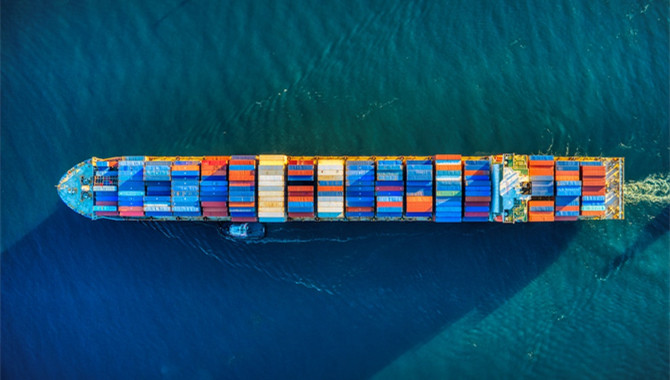The shipping industry has a crucial impact on the development of human society, not only because ships carry more than 80 percent of global trade by volume and more than 70 percent by value, but also because of its potential impact on climate change.
International shipping is responsible for about 3 percent of the total global greenhouse gas emissions; if shipping was a nation, it would be the sixth-largest emitting nation. According to the Fourth International Maritime Organization Greenhouse Gas Study 2020, emissions from international shipping could increase up to 40 percent of 2008 level by 2050.
Maritime shipments declined 3.8 percent in 2020, because of the COVID-19 pandemic, but they bounced back by about 7 percent in 2021. While that is a welcome change, the rise in emissions is unwelcome.
Global maritime trade is projected to see an annual average increase of 2.1 percent for the period 2023-27, which is a slower rate than the previous three-decade average of 3.3 percent but still an increase. As a short-term measure to curb emissions, in 2021 the IMO members agreed to reduce the carbon intensity of all ships by 40 percent from the 2008 level by 2030. The adopted long-term measure will be revised this year.
Being the world's largest shipbuilder and shipowner (ranked by commercial value), China, with its strategy and practice on shipping, can have profound influence on the global shipping industry. China is determined to proactively participate in global cooperation on addressing climate change, and there are several measures that China can take to green its shipping industry.
An ambitious carbon emissions reduction target and detailed green development road map are crucial for China's future shipping sector development. This year, the IMO is expected to revise the 2018 Initial IMO GHG Strategy with a more ambitious long-term measure, which will require all member countries, including China, to follow. In parallel, China has committed to achieving carbon neutrality before 2060. Therefore, China should accelerate the adoption of an ambitious carbon emissions reduction target on shipping with yearly basis measures and a detailed green development road map with supporting regulations.
A market-based mechanism, also referred to as a carbon emissions trading system or carbon market, is recognized as one of the most cost-effective policies for climate mitigation that can incentivize the shipping industry's decarbonization, as it can create a powerful economic incentive for businesses and individuals to reduce emissions.
The European Union has adopted such an approach to manage its shipping emissions. In December 2022, EU legislators agreed to include maritime transport within the EU's emission trading scheme starting from 2024, a move that will force ship operators to pay for their carbon emissions for the first time.
To ensure an effective green transition for the shipping sector, China could also consider adopting such an approach. China launched the world's largest carbon emissions trading system in 2021, which makes an emissions trading mechanism ready for the shipping sector. In addition, China already has a policy in place to collect necessary data from the shipping industry, which is the foundation for implementing the market-based mechanism. Furthermore, Shanghai has already covered the shipping sector under its local carbon market. Its experiences and lessons will be valuable for a national effort.
Besides the market-based mechanism, the most important and direct approaches to reduce carbon emissions from the shipping industry are replacing fossil fuels with green fuels, which are produced by renewable energy to ensure zero carbon emissions of burning such fuels, and upgrading relevant infrastructure.
Research and tests for different types of green fuels are still ongoing. Hydrogen, for example, is one of the green fuels that can help solve some of the world's most pressing energy challenges, but as it is an indirect short-lived greenhouse gas, its potential leakage needs to be carefully managed. Liquefied natural gas — which received the most attention in China as the next generation type of fuel for the shipping sector's future low carbon development — is still a fossil fuel with potential risk of methane leakage. In comparison, green ammonia is under the spotlight as it does not require cryogenic storage and complicated onboard processing in internal combustion, and has risk management standards and procedures in place.
Developing green ammonia would also be beneficial for the chemical industry's green transition as it eliminates coal consumption in producing procedures. In this regard, China needs to consider the development of green fuels in a comprehensive manner and make early deployment.
With all the above-mentioned solutions, China can start with a pilot to accelerate its green shipping practice. Developing such a pilot at a port city can enhance the practice of synergetic control of conventional pollution and carbon emissions for a healthier environment for surrounding communities. In addition, the pilot experiences could be borrowed and adopted by other ports all over China on incentivizing their local green economic growth.
As the shipping sector plays a pivotal role not only in the global economy but also in addressing climate change, the green transition of the shipping industry is an important component to help China achieve its carbon neutral commitment and a great contribution to address global climate change. Through cooperation with other developing countries, China could also make a great contribution to the green and sustainable development of the global shipping industry.
Source: China Daily
The opinions expressed herein are the author's and not necessarily those of The Xinde Marine News.
Please Contact Us at:
media@xindemarine.com


 Ningbo Containerized Freight Index Weekly Commentar
Ningbo Containerized Freight Index Weekly Commentar  Ningbo Containerized Freight Index Weekly Commentar
Ningbo Containerized Freight Index Weekly Commentar  Ningbo Containerized Freight Index Weekly Commentar
Ningbo Containerized Freight Index Weekly Commentar  BIMCO Shipping Number of the Week: Bulker newbuildi
BIMCO Shipping Number of the Week: Bulker newbuildi  Ningbo Containerized Freight Index Weekly Commentar
Ningbo Containerized Freight Index Weekly Commentar  Ningbo Containerized Freight Index Weekly Commentar
Ningbo Containerized Freight Index Weekly Commentar